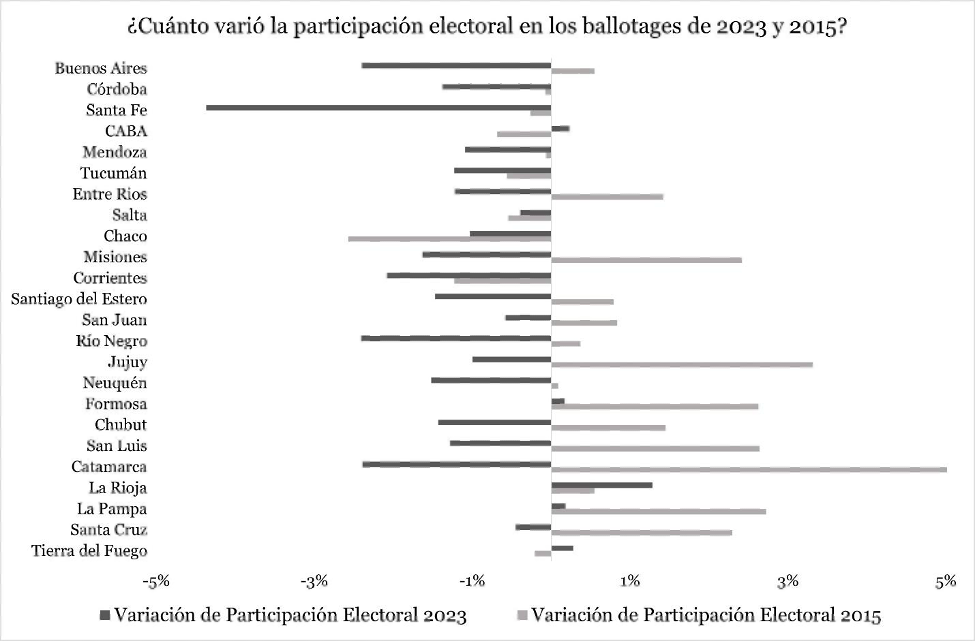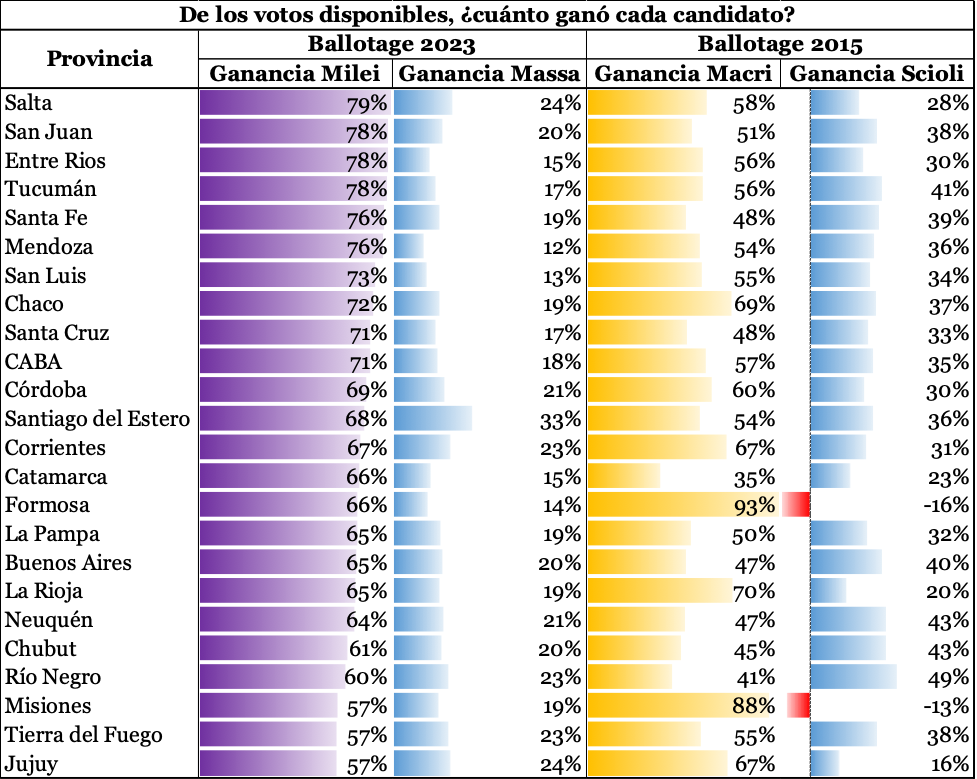
Analysis of the turnout in the Argentinean ballotage
In this post, we invite Facu Cruz, a tireless researcher of Argentines' electoral behaviour, to share part of the Cenital team's analysis of the recent presidential elections in Argentina, on the enigmatic -always- influence of turnout on the outcome of the second round (ballotage), which bore little resemblance to the result of the first round.
It would seem that the change in voter turnout between second rounds was key to the presidential result that handed victory to candidate Milei, but that is not the case. It is true that more people voted in 2015 than in the two rounds of 2023, both in the first (81.07%) and the second round (80.77%). But the provincial variation in voter turnout was not very different if we compare the two pairs of elections. Take a look.

Fuente: Centre of Research For Democratic Quality (CICaD).
The bar chart shows how much voter turnout varied in percentage terms by province. It is ordered from those with the highest electoral weight to those with the lowest. If the bar goes to the left, then voter turnout fell. If it goes to the right, it went up. Overall, the average change in voter turnout in 2023 was -1.13% and in 2015 it was 0.88%. Very marginal, practically imperceptible. Add to that the fact that the scale of the graph goes from -5% to 5%, which indicates that, even if you see very long bars and very short bars, the differences are minimal between pairs of elections.
Now pay attention for a while to the two greyscales. The darker one is this year's variation and the lighter one is that of previous elections. 10 districts out of 24 had the same electoral behaviour: either turnout went up between the two elections, or it went down. There are few cases that indicate a striking opposite behaviour when comparing the 2023 cycle with the 2015 cycle. That is to say that the dark bar goes to one side and the light bar to the other in similar proportions. Only Entre Ríos, Misiones, Jujuy, San Luis, Chubut and Catamarca stand out. In all of them, it fell in 2023 and rose in 2015.
Perhaps the only notable milestone in this change in the electorate's behaviour is the province of Buenos Aires. While in the first round of voting it rose by 0.55%, in this second round it fell by 2.4%.
But that is not the story.
Available voters
The story of the victory of La Libertad Avanza (LLA) is told by the ability to fish among available voters. In addition to the orphan voters - those who have no political representation in a second round because their candidates were left out - I will also add the undecided: those who voted blank or null in the first round election. These are important because, although they did not express themselves for any of the possible options, they may want to do so now given the purely dichotomous logic of a run-off. They are also tempting for the campaigns because they left their homes on a Sunday to vote and did something with the envelope given to them by the presiding officer.
All of them, orphaned and undecided, vote in an almost purely strategic way. They are available and they are worth gold.

Source: Research Centre for Democratic Quality (CICaD). The 2023 ballotage takes into account the provisional ballot, while the 2015 ballot takes into account the final ballot.
The table above has two calculations. First, I took the difference in positive votes between the second and first round for each presidential candidate. In a second instance, I divided that value by the sum of all those who did not make it to the second round (orphans), together with the blank and null votes (undecided). The value of each cell shows, then, what percentage of the available voters each presidential candidate of each political force won. It is ordered from highest to lowest following Milei's column.
As you can see, the supreme leader of the LLA won between half and three quarters of everything that was left hanging around in the first round of the October presidential election. Behind the lion's head, not only did the entire vote for Juntos por el Cambio go, but so did many undecided voters.
Massa, on the other hand, barely reached a third of those available, with rather minor variations between districts. In fact, Milei's average fishing rate was 68% while that of the Peronist candidate stood at 19%. An abysmal distance.
It is precisely this difference that explains why the 2015 ballot was much harder fought than the one in 2023. In the last two columns you can see the same calculation for Macri and Scioli. The Cambiemos candidate had greater provincial variation in his success in capturing the available voters, with provinces where he achieved 93% (Formosa, a small district) and others where he only reached 35% (Catamarca, another small one). The Frente para la Victoria leader reached 49% as its maximum (Río Negro, a medium-sized one) and had two negative ones due to loss of votes (Formosa and Misiones). Overall, the former achieved an average of 57%, while the latter reached 30% (34% if I take out the negatives). The distance in the success of convincing orphans and undecided voters was much smaller between the two. It is precisely this point that explains the difference in the distance between the competitors to which I referred earlier. On this side it goes that in this 2023 the defeat was almost 12 points and in 2015 only 2.68%.
Is there a reason for this result? There are plenty. I'll stick with three points mentioned by Matías Tarillo himself in that thread I linked you to, which helped me find some. With a voter turnout that remained at similar levels between October and November, last Sunday's vote was strategic and economic along the same lines. The indices speak for themselves: it is difficult to win in a context of crisis like the current one. In addition, Milei changed his rhetoric from anti-caste to anti-Peronism. If we also consider that the majority of undecided voters went with him, then a three-thirds scenario would put two against one. The change in the order of preferences worked in his favour among the available voters. His rhetoric, characteristics and promises resonated better with this base. That tipped the scales, much more sharply than eight years ago. The two drivers, economic crisis and anti-Peronism, mobilised much more towards the lion than in the previous ballotage towards the Calabrian.
It is mathematics. There is no other way round.









Add comment